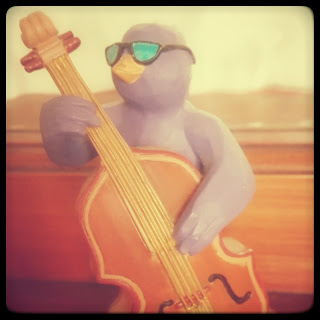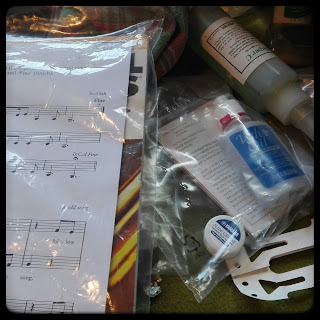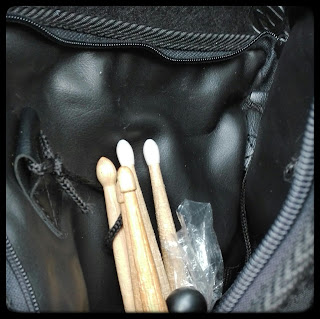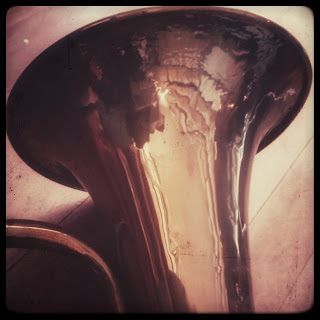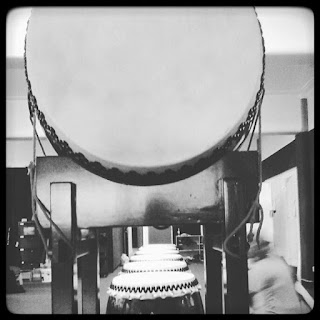It was only my second
time conducting the choir when the hand went up for the third time in about as
many minutes. “Excuse me.” Always so polite. “I don’t think that harmony part is
right.”
Monday, 25 July 2016
Monday, 18 July 2016
Teaching Note Reading
A word of warning:
This is going to be very treble clef-centric.
Alto, bass, and both treble/bass readers, adjust as necessary.
Monday, 11 July 2016
Teaching an instrument you don't play
Yesterday my phone
rang. On the line was the Musical
Director of a local music school. “What
are you doing tomorrow afternoon?” he boomed down the phone. My eyes narrowed. I’d heard those words before and I knew to be
wary.
“That depends,” I
replied. “Good,” he said, ignoring
me. “Can you take John’s guitar classes
please.”
And that is how I found myself teaching four
guitar classes – from beginner to intermediate levels.
Monday, 4 July 2016
Be the person you needed
There’s a meme
floating around online at the moment, sometime attributed to that fabulous
writer “Unknown” and sometimes to former BuzzFeed writer Ayesha A. Siddiqi that says “Be the personyou needed when you were younger”. Now, I’m not one to go crazy over these
“inspirational” quotes that pop up on my facebook and Instagram feeds, but this
one did make me think (so much so that it’s actually my current screen saver).
Monday, 27 June 2016
Monday, 20 June 2016
Chamber Music Coaching - what to wear
Traditionally
I get my younger groups to wear a white top and black trousers/skirt and my
older groups to wear all black. This is
a formal occasion, so try hard to avoid black jeans, t shirts with writing and
sneakers.
I prefer hair tied back, but
that’s just me. Feel free to argue that
one. But it does look tidier. I try to avoid “gimmicky” costumes. It distracts from the music and the
performances.
Little unifying touches
such as matching ties, waistcoats, hair ties are fine. I once had a group perform a medley from
“Carmen” and they wore a rose tucked discretely in their hair, which was a nice
reference to the opera and identified them as a group.
Friday, 17 June 2016
Chamber Music - Stagecraft
Stagecraft:
I’ve
watched many chamber music contests in my time.
Many. And I feel that stagecraft
is the thing that either gets left literally till the last moment (the teacher
whispers a hurried “BOW!” just as the students are about to go on stage), or
never gets addressed at all. But for me,
stage etiquette is just as important as preparing the music.
Coming
on stage
Decide
who will come on first. Think about this
logically. If you are coaching a flute
trio using three music stands, it makes sense to come on (if entering the stage
from Stage Left)
Player 2 Player 1 Player
3
Why?
Because
they’ll be coming on in front of their music stands to introduce their
piece. Then, after the introduction,
Player 2 moves to their stand from the left, Player 1 follows, and Player 3
turns to the right and moves to their stand.
It’s kinda hard to explain in words.
Try it with three different coloured pens or something. You’ll see what I mean.
If you
are a flute quartet, you would come on
Player 2 Player 1 Player
4 Player 3
The same
thing happens. Players 2 and 1 move to
the left. Players 4 and 3 move to the
right, then BOOM – you’re in the right order.
Think
about your ensemble and what makes sense for where they are positioned on
stage. (Page turners – you’re not
actually part of the ensemble. This
means you don’t come up the front when the performers are introducing the piece
and you don’t take a bow at the end.
Just come on stage after the players and head straight for the piano).
When the
group comes on stage, they should have their music in one hand and their
instrument in the other. If possible, I
like to have their instrument in the hand that is facing the audience. That way the audience (most of whom are proud
mums and dads and aren’t necessarily musical) can see. Music should be in a folder (at the very
least) and ideally should be matching. I
have made up black folders that my students all share. They are made of three pieces of black A4
cardboard that can be spread out for pieces that require 3 pages to reduce page
turns.
Once on
stage, don’t bow. The audience will have
started clapping the moment the players are on the stage and more often than
not they have stopped clapping by the time the players are in the middle. And then you get that awkward thing where
they don’t know whether to clap again, so some do and others don’t then
everyone laughs with awkward embarrassment and it’s just not worth it. Just walk (briskly) on stage and smile.
You
should have decided in advance who will speak and what they will say. Something along the lines of: “Good
[morning/afternoon/evening], we are [insert name here]. Today we will be performing [name of piece]
by [composer].” That’s it. No “witty” in jokes, no explanations of the
group name and no “We hope you enjoy our performance.” Because you know what? You say that to me, I lean back, cross my
arms and think “Yeah? Make me.” All you
need to say is a greeting (and “hi” or “g’day” or “umm…yeah…” are NOT
acceptable), who you are, what you’re going to do. That’s it.
No-one cares about anything else.
Once the introduction is over, go to
your music stands.
Why not
go to your music stands first, tune up, then address the audience? Because it’s rude. You don’t walk into someone’s house, make a
cup of tea, sit down, then say hello. Acknowledge
your audience first. It just makes
sense.
Once at
your stands, do adjust them so they’re in the right position and at the right
height for you. The stage manager will
have done their best to put things the way you want them, but they’re not
psychic. DON’T put your flute on the floor. Arrange beforehand which of your teammates
you’ll give it to while you adjust yourself.
Then return the favour for them. If you’re not familiar with how the
music stands operate, cast a look over at the stage manager. They’ll help you.
Tune up,
then begin the piece.
Finish
the piece.
At the
end, all lower your instruments at the same time (pianists excluded) and LEAVE
YOUR MUSIC WHERE IT IS. Seriously. Don’t touch it. Come back around to the front of your stands,
in reverse order of how you got there.
Don’t come through the middle of them.
Hold your instruments in an appropriate manner. One person needs to lead the bow. Everyone else looks at them out the corner of
their eyes and you bow together. Make
sure everyone is in the line before you start the bow.
How to
bow? Go straight down, then straight up
again. Pretend you’re in a barrel and
can only move down and up. Look at your
feet and in your head say “Ooh! I’m wearing shoes.” This is the correct amount of time to bow. Don’t flick your hair out of the way on the
way up, adjust it after you’ve stood back up if needed.
It’s a
lot to explain in words. Try it, step by
step and hopefully it should make sense to you.[i]
[i] If it makes you feel any better,
one parent, observing me coaching a group in stage etiquette, did remark that
it was like being in the army…
Wednesday, 15 June 2016
Chamber Music Coaching - Rehearsing
Rehearsal
process/procedure:
Advanced
players should be able to warm and tune up their own instruments. Less experienced players will need your
help. If possible, have them come 5 – 10
minutes before the rehearsal time so you can do this.
Monday, 13 June 2016
Chamber Music Coaching - what you'll need
What
you’ll need for rehearsals:
Score
and individual parts
Music
stands for everyone
Tuner +
metronome
Music
dictionary
Pencils
(not pens!)
Recording
of music
Recording
device (e.g. phone)
Friday, 10 June 2016
Coaching Chamber Music - initial set-up
It’s
coming up to chamber music contest season[i]. You may have had some of your students
request you find them some music, or they may have been given some music from
school.
Wednesday, 8 June 2016
How to tell off a student
It’s
tricky when you realise you have to discipline a student. You want them to like you, and by telling
someone off, you’re risking them not liking you. Or so you think…
Monday, 6 June 2016
Friday, 3 June 2016
Group Lessons - Classroom Management
Ahh, the
big one. The question every beginner
teacher asks: what if they’re naughty?
Firstly,
let me remind you that corporal punishment is illegal…
Wednesday, 1 June 2016
Group Lessons - Dealing With Non-Students in the Room
Sometimes
you have to deal with parents or other siblings in the room. Feel free to tell them to shut-up or go
away. Be as polite as you feel you need
to be.
Monday, 30 May 2016
Group Lessons - Differing Abilities
One
disadvantage to group lessons is that it’s harder to cater individual students’
needs. I try to structure lessons so all
of the group are working at the same place in the book. If a student is struggling, they will
appreciate the extra time working on a particular song or concept, and if a
student can play the notes correctly, there are still more things they could be
working on or thinking about.
Friday, 27 May 2016
Group Lessons - What to Teach
What to
teach in a group lesson really depends on the level of the students. Beginners will spend more time on
fundamentals of technique and using the tutor book. More advanced students can work on their
ensemble playing skills.
Wednesday, 25 May 2016
Group Lessons - Structuring a Lesson
I have
outlined lesson structure in an earlier post, so this post is specifically
about structuring a lesson for a group class.
Monday, 23 May 2016
Group Lessons - Creating a Community
Learning
music in a group is such a fantastic way of becoming part of a community. For me, this is what music is about.
Friday, 20 May 2016
Group Lessons - Physical Set-Up
The next
few posts will be specifically about teaching groups. Group teaching requires different skills than
teaching 1-1. I love that group lessons
are social, and it’s easier to create that sense of community that the very
essence of music. Group lessons are
ideal for teaching ensemble skills and provide a ready-made audience for solo
playing.
Wednesday, 18 May 2016
The First Lesson
This is
one of my favourite moments in the teaching year – the very first lesson of a
beginner student.
They
turn up, all shiny and new. And the
instruments turn up all shiny and new.
This might be the first time you’ve met the student/s and the first time
they’ve met you. Greet them in a
friendly manner, ask their name (even if you already know it) and tell them
your name – it’s super important.
The
first lesson is where you start to get to know your students. Ask some personal questions – what school do
you go to is always a good one. If you
know another student or a teacher or have some other connection with that
school, mention it. It’s a good
ice-breaker and it shows that not only are you interested in the student, but
on some level your worlds intersect.
Ask them
why they want to play music, or your instrument in particular. What are their
goals? Do they already have experience
with music? Explain that while you get
to know what they can do or can’t do, you’ll be asking lots of questions. You might explain things that they already
know (and it’s ok for them to say that they know it) or you might not explain
things you think they know but don’t (again, tell them it’s ok to ask for
clarification).
Then it’s
time to get down to business. Hand out
instruments, or if they already have it, have them open the case (and teach
them how to open the case if it’s not obvious!). I start by just looking at the flute. I get the student to touch the keys and see
which key moves which other keys. I talk about the different parts of the flute
and we play a silly game to learn the names of the parts.
Every
instrument is different and your approach to the beginning of lessons will be
different for each instrument. With the
flute, certainly the first lesson is spent just using the headjoint getting a
clear, consistent sound. You will need
to think carefully about your instrument, and how to best begin.
The
first lesson is also a good time to talk about taking care of instruments and
where to store them at home.
Make
sure you assign some kind of homework on this lesson – they’ll be excited and
want to show off what they learned. Keep
it easy and manageable, but do let them know your expectations. I’ll tell kids they need to play their flute
to everyone who comes to their house during the week – mum, Grandpa, the cat,
even the plumber. Lucky plumber…!
Monday, 16 May 2016
Teaching in Someone Else’s Space
You may
have a gig teaching in a school or an after school programme, where you’re
actually in another teacher’s classroom.
Friday, 13 May 2016
Setting up a studio - what gear do you need?
Your
instrument. That’s pretty helpful
(although there have been occasions when my flute has had a little
unintentional holiday…). Really, it
depends on what you’re teaching, what style of music you teach, and your style
of teaching.
Wednesday, 11 May 2016
Setting up a studio
Now it’s
time to get going. You need to decide
where you’ll be teaching from. You may
have a space in your house, you may be able to use a space in a school or
similar, or you may want to rent a studio.
Monday, 9 May 2016
Friday, 6 May 2016
How to use a tutor book
Once you’ve decided on a book or
books, you need to think carefully about how to make the best use of it. Will you follow it slavishly, playing every
single song and every single exercise?
Will you spend the entire lesson playing from the book? Will you pick and choose – taking parts of
the book to serve the point of the lesson?
What you do is up to you, but at
the beginning of your teaching career I’d recommend following the book. The author will be an experienced
teacher/musician, and will have thought carefully about the order of
progression. The book will usually begin
with how to produce a sound on the instrument and posture. You don’t have to get through these pages in
the first lesson. With the flute, I
don’t usually put the instrument together until at least the second lesson
(maybe the third or fourth). I need to
be sure the student has got a good, consistent sound with just the headjoint,
otherwise, the rest of their playing will sound awful. During these first few lessons I spend the time
in between trying to get a sound by talking about practising, where to store
the flute, basic music theory (stave/crotchets etc), and how to NOT give your
flute to your little sister to play. Or
if something goes wrong to bring the flute to me. Dad is NOT allowed to touch it.
Sorry. Rant over.[1]
I use
the tutor book sparingly in the first 10 or so weeks of playing. It’s more important to establish good habits
in these weeks than it is to churn through pages of the book. Once you get going with the book, it’s
important to make sure the students understand each new concept. In a group lesson I will use a whiteboard to
explain things like time signatures and bars.
In a 1-1 lesson I write it directly in the students’ book. Do be thorough and don’t accept sloppy
playing.
If a
student doesn’t understand a concept, or can’t play the song independently, use
the song as a “study”. Take the
trickiest part of the song and break it down to its core components. Isolate rhythms or tricky fingerings. I don’t recommend moving on in the book until
the student can play the entire song independently. In group lessons this is hard to find a
balance. I’ll discuss this in another
post.
It can
be fun to go over easy songs in the book.
Once in a while (e.g. at the beginning or end of a term) the class and I
will play every song in the book until we can’t go any further. This is great because it means we can see how
far we’ve come (suddenly that “hard” song isn’t all that hard any more) and we
can consolidate all the learning so far.
Wednesday, 4 May 2016
Choosing a Tutor Book
Which
tutor book you use for beginners depends on a few things. If you are teaching through an established
programme, the book may have been decided upon by someone else. If you are teaching a particular method (e.g.
Suzuki) then you will use the materials designed for that style. However, if you are trying to decide on a
tutor book for private students you may want to take the following into
account.
Monday, 2 May 2016
What to Teach – Technique
Technique
is an important factor of playing any instrument. This should form a major part of your
lesson. Why? Because technique is the
foundation on which we build our playing.
Because every piece we are going to play is going to contain technical
elements and if you can isolate and perfect them, then playing the piece is
going to be a million times easier.
Friday, 29 April 2016
The End of a Lesson
How to
end a lesson.
The end
of a lesson is a chance not only to consolidate what has been learned, but to also
to extend knowledge. Sometimes we need
to use the skills we already have. Think
of it like reading – yes, your reading skills are probably pretty advanced, but
you don’t always sit down to tackle Tolstoy.
What I’m saying, is that sometimes it’s just fun to play a piece for
fun.
Wednesday, 27 April 2016
Monday, 25 April 2016
Beginning of the Lesson
I begin
every lesson, group or individual with a warm-up. There are many purposes for a warm-up. It physically warms the body up, ready for
playing. In a group setting the warm-up
helps the players come together as an ensemble.
Some students may be late, and the warm-up serves as a time when they
can get their instruments ready and join in without missing any new
learning. Psychologically a warm-up
signals the beginning of the lesson, the time for non-related chat is over, and
we need to get ready to work.
Friday, 22 April 2016
Structuring a Lesson
It’s
important that a lesson has a structure to it.
The student gains comfort from this, alleviating any anxiety about
what’s coming up next and you know that you are covering what you need to in
the lesson. Sometimes when you break
from the regular structure there is a sense of freshness to the lesson.
It makes
sense to structure the lesson. The
beginning activities/warm-ups can lead into the focus of the main part of the
lesson. The body of the lesson is where
you will teach a particular concept and then the ending can reinforce the main
concept or consolidate prior knowledge.
The flow of the lesson feels organic and logical.
Wednesday, 20 April 2016
Qualifications
What
qualifications do you need to teach music?
Technically,
nothing. You could set yourself up right
now as a music teacher, with no letters beside your name, no years of lessons
behind you, no knowledge of your instrument or repertoire. Of course, if you did that, you’d also have
no students.
If you
want to keep and retain students, you will need to have some kind of training
behind you.
Monday, 18 April 2016
Examining Your Own Musical Education
Your own music education.
In order
to be an effective teacher, you need to look back before you can look
forwards. It’s helpful to examine your
own musical background to determine how it affects your outlook on teaching. Everything that you’ve experienced
contributes to your attitude to teaching.
You have a unique set of experiences that you can draw on in order to
become a teacher. Most of your own
history you have experienced as a learner and you haven’t thought about them
through the lens of teaching.
Friday, 15 April 2016
Philosophy of Music Education
Philosophy of Music Education
There
are different methods of teaching music that people have developed over the
years (e.g. Suzuki, Kodaly, Orff). I’ll
look at them in further posts. More
often than not, studio teachers use various aspects of these methods, but
generally they follow what their own teacher/s taught them, as unless they’ve
made a specific study of that method, there are no established guidelines for
studio music teachers. No matter what
method they use, their teaching will be based on their own musical philosophy.
Wednesday, 13 April 2016
Learn Their Names!
It’s not
rocket science – learn the names of your students! (And make sure they know
yours!)
Why is
this important? Mostly because it’s
basic manners, isn’t it?
Your
name is part of your identity. It aligns
you with your family and culture, and at the same time it distinguishes you as
an individual.
When we
hear someone saying our name (correctly – has anyone ever met Justin
Pierce/Perry/Piree…?? I certainly haven't despite many people asking me...) it is meaningful to us.
It means someone has taken the time to get to know us, even if it’s just
a little bit. Saying someone’s name
acknowledges their humanity.
So, even
if you are just filling in for the regular teacher, make it a point to learn
your students’ names.
Tuesday, 12 April 2016
Theories of Learning
It’s important to understand how people
learn. There are loads of theories about
learning and human development. Many of
them encompass beliefs from many cultures.
Here’s a
brief overview of some. Have a think about how they fit in with your
beliefs.
What Makes a Good Teacher?
Have a
think about the best teachers you’ve ever had (all your teachers, not necessarily
just your music teachers). What made
them good? Did they make you learn more
than other teachers? How did they make
you feel? What kind of environment did
they create in their classroom? How did
they feel about their subject?
Introduction
Well
done! You made it to F Sharks and Cannonballs. I’m Justine and I’m the Captain of SS Music
Teacher. My aim is to lead you through
the murky waters of music teaching. To
circumnavigate the seas of - actually, I might ditch that analogy…
Subscribe to:
Comments (Atom)




